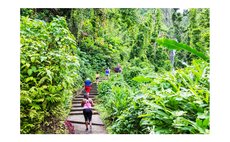How Hurricane Maria Ravaged Dominica's Botanic Gardens
By Arlington James
The morning after Hurricane Maria mercilessly battered Dominica, one of my friends who had "navigated" his way through the mess that was once Dominica's scenic Botanic Gardens exclaimed, "Man, you must see Gardens! Gardens finish!"
The following day (Wednesday 20th September 2017) I jumped over landslide rubble, uprooted trees, sheets of galvanize, etc, along the Elmshall Road making my way down to "see Gardens" for myself. The scene that greeted me was certainly not a welcoming one.
The Elmshall Gate was blocked by an uprooted clump of Fish Tail Palms. Fallen trees obstructed the road through the Gardens at several points. Huge, 120 year-old trees were lying on their side. Large limbs and branches were broken off once magnificent trees which were left standing, but with much-reduced and misshapen crowns. Some palms were leafless, while one of the largest trees in the Gardens was left with a long split running down its stem. To add to the scene, twisted sheets of "galvanise" were strewn helter-skelter, with one trapped between the roots of an uprooted tree.
Some weeks following my initial shock from my first post-Maria visit to the Gardens, retired Forest Officer/National Parks David Williams and I decided to combine our expertise to voluntarily undertake an assessment of the impacts of the hurricane on the collection of ornamental trees and shrubs of the Botanic Gardens and Peebles Park.
We began the assignment on 8th November 2017 and spent four half-days collecting data. The compilation of our findings was completed in January 2018, bearing in mind that neither my colleague nor myself had electricity at our respective homes, and we gratefully thank the Editor and Staff of The Sun newspaper, who permitted us to use their facilities and equipment to prepare the report.
Our survey revealed that Hurricane Maria had destroyed 168 trees on the Botanic Gardens' grounds, comprising 157 ornamental forest trees and 11 fruit trees and trees of economical or cultural significance. Additionally, five ornamental shrubs were lost.
Fortunately, no trees or shrubs were lost from the small plant collection at Peebles Park.
Tree mortality at the Gardens resulting from "Maria" was distributed among 59 ornamental tree species and 10 species of fruit trees and trees of economic importance.
It is important to note that mortalities among the ornamental/forest trees included 56 trees from 21 species for which there were no "survivors" or duplicates at the Gardens. Trees in that "mortalities with no survivors" group included the 3 "Monkey Tambrin" (Velvet Tamarind) trees; 19 Fish Tail Palms; the 12 Blue Mahoe trees near 35 Steps; the 2 Gouglou Palms; and single specimens of Eucalyptus, Colville's Glory and Red Cedar, among other species.
For the other mortalities, fortunately there are duplicates of those trees at the Gardens. For example, Hurricane Maria destroyed 5 of the Saman trees – including the oldest and largest, but left 3 standing. The hurricane claimed 10 Manila or "Pacific" Palms, but 41 remain. The storm also killed 4 Bwa Kwaib trees – not including another that was inadvertently cut down - but one of the two survivors was planted by H.R.H. Princess Ann in the early 2000s.
Meantime, three Norfolk Island Pines were uprooted, leaving the 6 survivors looking like all of their branches had been practically plucked from the stems. The large Bermuda Cedar, which the Bwa-Bwa folks used for mounting onto their stilts as well as two other Bermuda Cedars, were killed by the hurricane, but six survived. Also, one of the rarest trees in the Gardens, the Pride of Burma had one mortality and one survivor.
The list of mortalities with survivors is considerably longer than the "no-survivors" list.
Dominica's Botanic Gardens is known for a few iconic trees such as the Sausage Tree, the African Baobab, the huge Banyan Tree, the Talipot or "Century" Palm, the large Albizia or "Zing-Zing" tree, and some tree-like plants e.g. the "Bamboo House", and others.
Some of those "iconics" were ravaged by the hurricane but are still standing, with badly damaged crowns, e.g. the Banyan and the Baobab. Damage to the "Bamboo House" was minimal, while a few of the other iconics such as the Velvet Tamarind, and some of the Mahoganies and Samans were uprooted.
The question has been asked, whether our Gardens will ever return to its pre-Hurricane Maria state. The fact is, over the 127 years of its existence, Dominica's Botanic Gardens has been battered by strong hurricanes on several occasions. However, possibly the worst body-blow may have been inflicted by Hurricane Maria.
Whether the lost trees with no survivors will ever be replaced will be left to be seen. However, the Gardens will remain a very important site with educational, touristic, social and cultural values on the Dominican landscape.




